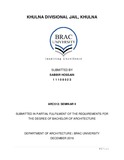| dc.contributor.advisor | Reza, Habib | |
| dc.contributor.advisor | Doja, Sajid Bin | |
| dc.contributor.author | Hossain, Sabbir | |
| dc.date.accessioned | 2021-10-26T05:03:55Z | |
| dc.date.available | 2021-10-26T05:03:55Z | |
| dc.date.copyright | 2016 | |
| dc.date.issued | 2016 | |
| dc.identifier.other | ID 11108023 | |
| dc.identifier.uri | http://hdl.handle.net/10361/15542 | |
| dc.description | This thesis is submitted in partial fulfillment of the requirements for the degree of Bachelor of Architecture, 2016. | en_US |
| dc.description | Cataloged from PDF version of thesis. | |
| dc.description | Includes bibliographical references (page 49). | |
| dc.description.abstract | The crime rate of Bangladesh is increasing rapidly , so new jails are being made to address this massive loads on the prison cells. The central jail located in Dhaka Lalbag is relocated to Keranigonj due to the incapability of the existing infrastructure to carry the heavy pressure. Like Dhaka Central jail, a new divisional jail has been proposed in Dumuria of Khulna to disperse the pressure on the existing Khulna division jail as the capacity of it is very low . This Khulna jail will have the capacity to accommodate 2000 prisoner for now and later it will be extended to hold a maximum capacity of 4000 prisoner in total. This paper reflects on the whole process of how Khulna central jail can be designed on the proposed site addressing the program and required functional details. The process contains the details of how the project has been rationalized to its context , fixation of design objectives, program generation, case studies, zoning of site having a basic concept of retaining the topographic uniqueness, characteristics of the nature of surrounding areas and serenity of the proposed site. In many cases people think prison means a place where the criminals get punished because of their wrong doings and they are being isolated and separated from the society. This project aims to create a maximum security prison where the prisoners can improve themselves through various activities and when they go back to the society, they will be able to cope up with the society. The jail is envisioned more as a rehabilitation and correctional facilities rather than a punishing machine, that will help the guilty prisoners to remorse for their wrong deeds in isolation and will prepare them with skills and good morale when they go back to the society as a changed person. | en_US |
| dc.format.extent | 49 pages | |
| dc.language.iso | en | en_US |
| dc.publisher | Brac University | en_US |
| dc.rights | Brac University theses are protected by copyright. They may be viewed from this source for any purpose, but reproduction or distribution in any format is prohibited without written permission. | |
| dc.subject | Khulna | en_US |
| dc.subject | Divisional jail | en_US |
| dc.subject | Rehabilitation | en_US |
| dc.subject | Correction | en_US |
| dc.subject | Skill development | en_US |
| dc.subject.lcsh | Architectural design | |
| dc.title | Khulna divisional jail, Khulna | en_US |
| dc.type | Thesis | en_US |
| dc.contributor.department | Department of Architecture, Brac University | |
| dc.description.degree | B. Architecture | |
| dc.description.degree | Sabbir Hossain | |

